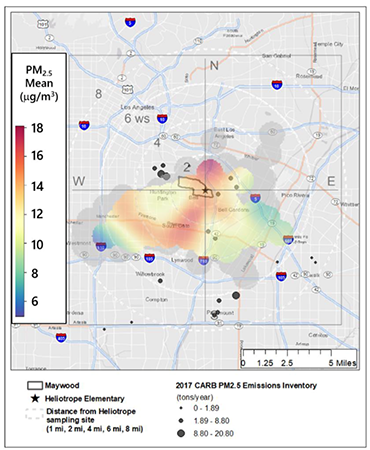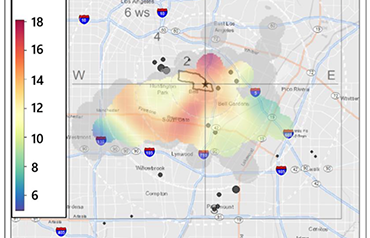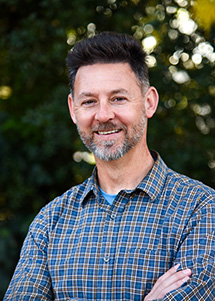Community Air Quality Monitoring in Maywood, California
Clients
Coalition for Clean Air
Comite Pro Uno
California Air Resources Board (CARB)
The community of Maywood in Los Angeles County, CA, is surrounded by freeways with heavy truck traffic, a major railyard, and industrial facilities. The community is in the highest decile of the environmental justice (EJ) index for air pollution in California, according to the California Office of Environmental Health Hazard Assessment’s <a href="https://oehha.ca.gov/calenviroscreen/report/calenviroscreen-40" target="_new">CalEnviroScreen mapping tool</a href>. From May to July 2019, Sonoma Technology scientists collected air pollution measurements at Heliotrope Elementary School in Maywood to determine the sources and concentrations of metals, hexavalent chromium [Cr(VI)], and diesel particulate matter (DPM), and to estimate the health risks to the community.</p>
Hourly samples were collected for speciated metals using an Xact 625i, black carbon (BC) using an AE33 Aethalometer, particulate matter less than 2.5 microns (PM<sub>2.5</sub>) using a T640 instrument, Cr(VI) measurements via filter sampling, and environmental parameters using meteorological instruments. Analysis of the samples showed the following:</p>
<ul><li>Cr(VI) concentrations were typical of urban Los Angeles levels, with cancer risk of 2-in-a-million. Arsenic was the metal with the highest cancer risk, of 3-in-a-million, while DPM had a cancer risk of 202-per-million.</li>
<li>Arsenic appeared to predominantly come from re-entrained dust that had been contaminated over previous decades from local arsenic emissions.</li>
<li>Lead was predominantly from local sources, with an additional contribution from dust.</li>
<li>Barium and copper correlated closely with BC, likely originating from non-exhaust vehicle emissions.</li>
<li>Local industrial sources were the main contributors to chromium and nickel concentrations.</li>
<li>DPM concentrations were from a combination of emissions from the I-710 freeway and local arterial roads.</li>
<li>On July 4, concentrations of metals were 10 to 440 times higher than normal due to fireworks.</li></ul>
Overall, these findings are being used by the community to develop a community action plan for Maywood as part of the Community Air Protection Program (CAPP) established by CARB’s response to Assembly Bill (AB) 617. This work was funded as part of the Maywood Comprehensive Air Quality Program from a CARB Community Air Grant under the umbrella of the California Climate Investments (CCI). CCI is a statewide program that puts billions of Cap-and-Trade dollars to work reducing greenhouse gas emissions, strengthening the economy and improving public health and the environment, particularly in disadvantaged communities.
Hourly samples were collected for speciated metals using an Xact 625i, black carbon (BC) using an AE33 Aethalometer, particulate matter less than 2.5 microns (PM<sub>2.5</sub>) using a T640 instrument, Cr(VI) measurements via filter sampling, and environmental parameters using meteorological instruments. Analysis of the samples showed the following:</p>
<ul><li>Cr(VI) concentrations were typical of urban Los Angeles levels, with cancer risk of 2-in-a-million. Arsenic was the metal with the highest cancer risk, of 3-in-a-million, while DPM had a cancer risk of 202-per-million.</li>
<li>Arsenic appeared to predominantly come from re-entrained dust that had been contaminated over previous decades from local arsenic emissions.</li>
<li>Lead was predominantly from local sources, with an additional contribution from dust.</li>
<li>Barium and copper correlated closely with BC, likely originating from non-exhaust vehicle emissions.</li>
<li>Local industrial sources were the main contributors to chromium and nickel concentrations.</li>
<li>DPM concentrations were from a combination of emissions from the I-710 freeway and local arterial roads.</li>
<li>On July 4, concentrations of metals were 10 to 440 times higher than normal due to fireworks.</li></ul>
Overall, these findings are being used by the community to develop a community action plan for Maywood as part of the Community Air Protection Program (CAPP) established by CARB’s response to Assembly Bill (AB) 617. This work was funded as part of the Maywood Comprehensive Air Quality Program from a CARB Community Air Grant under the umbrella of the California Climate Investments (CCI). CCI is a statewide program that puts billions of Cap-and-Trade dollars to work reducing greenhouse gas emissions, strengthening the economy and improving public health and the environment, particularly in disadvantaged communities.
Air Quality
Community Monitoring
Exposure
Measurements
Modeling
Policy and Planning
Public Outreach
Training Courses


Steve G. Brown

Steve
G.
Brown
Northern California Regional Director / Senior Atmospheric Scientist
sbrown@sonomatech.com
/sites/default/files/2023-07/SGBres.pdf
